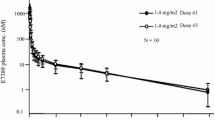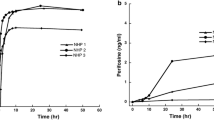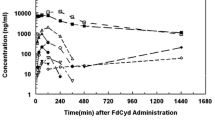Abstract
Purpose
Cyclin-dependent kinases (CDKs) play a significant role in the control of cell-cycle progression and exhibit aberrant regulation in various neoplastic diseases. AG-024322 is a potent inhibitor of CDK1, CDK2, and CDK4 that produces cell-cycle arrest and antitumor activity in preclinical models. This study evaluated the toxicity of AG-024322 when given by intravenous (IV) infusion to cynomolgus monkeys, including reversibility of effects.
Methods
Male and female monkeys received AG-024322 by 30-min IV infusion once daily for 5 days at doses of 2, 6, and 10 mg/kg (24, 72, and 120 mg/m2, respectively). Controls received vehicle alone which was aqueous 5% dextrose, pH 3.8. Three animals/sex/group were necropsied on day 6, and two animals/sex/group at 6 and 10 mg/kg were necropsied on day 22 (reversal cohort). Doses were based upon the results of a dose range-finding study in monkeys; decreased white blood cells occurred at ≥3 mg/kg and 12 mg/kg produced central nervous system effects and was above the maximum-tolerated dose.
Results
No deaths occurred and clinical signs of toxicity, including swelling at the IV administration site, were seen at ≥6 mg/kg. AG-024322 at ≥6 mg/kg produced pancytic bone marrow hypocellularity, lymphoid depletion, and vascular injury at the injection site. Renal tubular degeneration occurred at 10 mg/kg. These changes were either reversible or in a process of repair following the 17-day recovery period. Hematology changes included decreases in reticulocytes and/or granulocytes at ≥6 mg/kg, which were reversible and consistent with changes in the bone marrow. Lymphoid and bone marrow depletion are consistent with pharmacologic inhibition of CDKs by AG-024322 and were expected findings. On day 22, vacuolar degeneration of pancreatic acinar cells with increased serum amylase and lipase levels occurred in one female at 10 mg/kg. Neither sex-related differences in toxicokinetics nor plasma accumulation over 5 days of dosing were seen. Terminal phase overall mean half-life on day 5 ranged from 6.69 to 8.87 h (across dose levels) and was not dose dependent.
Conclusion
The no-adverse-effect dose of AG-024322 was 2 mg/kg and associated with overall mean plasma AUC(0–24.5) of 2.11 μg h/mL.

Similar content being viewed by others
References
Arguello F, Alexander M, Sterry JA, Gabriela T, Smith EM, Kalavar NT, Greene JF, Koss W, Morgan CD, Stinson SF, Siford TJ, Alvord WG, Klabansky RL, Sausville EA (1998) Flavopiridol induces apoptosis of normal lymphoid cells, causes immunosuppression, and has potent antitumor activity in vivo against human leukemia and lymphoma xenografts. Blood 91(7):2482–2490
Baughn LB, Di Liberto M, Wu K, Toogood PL, Louie T, Gottschalk R, Niesvizky R, Cho H, Ely S, Moore MAS, Chen-Kiang S (2006) A novel orally active small molecule potently induces G1 arrest in primary myeloma cells and prevents tumor growth by specific inhibition of cyclin-dependent kinase 4/6. Cancer Res 66(15):7661–7667
Fink JR, LeBien TW (2001) Novel expression of cyclin-dependent kinase inhibitors in human B-cell precursors. Exp Hematol 29:490–498
Fischer PM, Gianella-Borradori A (2003) CDK inhibitors in clinical development for the treatment of cancer. Expert Opin Investig Drugs 12(6):955–970
Fry DW, Bedford DC, Harvey PH, Fritsch A, Keller PR, Wu Z, Dobrusin E, Leopold WR, Fattaey A, Garrett MD (2001) Cell cycle and biochemical effects of PD 0183812, a potent inhibitor of the cyclin D-dependent kinases CDK4 and CDK6. J Biol Chem 276(20):16617–16623
Fry DW, Harvey PJ, Keller PR, Elliott WL, Meade M, Trachet E, Albassam M, Zheng X, Leopold WR, Pryer NK, Toogood PL (2004) Specific inhibition of cyclin-dependent kinase 4/6 by PD 0332991 and associated antitumor activity in human tumor xenografts. Mol Cancer Ther 3(11):1427–1437
Furukawa Y, Kikuchi J, Nakamura M, Iwase S, Yamada H, Matsuda M (2000) Lineage-specific regulation of cell cycle control gene expression during haematopoetic cell differentiation. Br J Haematol 110:663–673
Garrett MD, Fattaey A (1999) CDK inhibition and cancer therapy. Curr Opin Genet Dev 9:104–111
Jessen BA, Lee L, Koudriakova T, Haines M, Lundgren K, Price S, Nonomiya J, Lewis C, Stevens GJ (2007) Peripheral white blood cell toxicity induced by broad spectrum cyclin-dependent kinase inhibitors. J Appl Toxicol 27:133–142
Kim JH, Kang MJ, Park CU, Kwak HJ, Hwang Y, Koh GY (1999) Amplified CDK2 and cdc2 activities in primary colorectal carcinoma. Cancer 85(3):546–553
Ko TC, Bresnahan WA, Thompson EA (1997) Intestinal cell cycle regulation. Prog Cell Cycle Res 3:43–52
O’Dwyer PJ, LoRussso P, DeMichele A, Gupta V, Barbi A, Dials H, Chen I, Courtney R, Wilner K, Schwartz GK (2007). Phase I dose escalation trial of a daily oral CDK 4/6 inhibitor PD-0332991. J Clin Oncol. 2007 ASCO annual meeting proceed part 1. vol 25. no 18S (abstract 3550)
Ramiro-Ibanez F, Trajkovic D, Jessen B (2005) Gastric and pancreatic lesions in rats treated with a pan-CDK inhibitor. Toxicol Pathol 33:784–791
Rixe O, Fojo T (2007) Is cell death a critical end point for anticancer therapies or is cytostasis sufficient? Clin Cancer Res 13(24):7280–7287
Shapiro GI (2004) Preclinical and clinical development of the cyclin-dependent kinase inhibitor flavopiridol. Clin Cancer Res (suppl) 10:4270s–4275s
Sherr CJ (1995) D-type cyclins. Trends Biol Sci 20:187–190
Sherr CJ (1996) Cancer cell cycles. Science 274:1672–1677
Stadler WM, Vogelzang NJ, Amato R, Sosman J, Taber D, Liebowitz D, Vokes EE (2000) Flavopiridol, a novel cyclin-dependent kinase inhibitor, in metastatic renal cancer: a University of Chicago Phase II consortium study. J Clin Oncol 18(2):371–375
Tan AR, Headlee D, Messman R, Sausville EA, Arbuck SG, Murgo AJ, Melillo G, Zhai S, Figg WD, Swain SM, Senderowicz AM (2002) Phase I clinical and pharmacokinetic study of flavopiridol administered as a daily 1-hour infusion in patients with advanced neoplasms. J Clin Oncol 20(19):4074–4082
Tetsu O, McCormick F (2003) Proliferation of cancer cells despite CDK2 inhibition. Cancer Cell 3:233–245
Zhang CC, Kephart S, McAlpine I, Nonomiya J, Higgins J, Arango ME, Yan Z, Knighton D, Ferre RA, Tikhe J, Verkhivker G, Xu M, Romines W, Palmer C, Park J, Reich S, Chong W, Li L, Los G, Lewis C (2005) AG-024322 is a potent and selective multi-targeted CDK inhibitor with broad spectrum anti-proliferative activity. Proc Am Assoc Cancer Res 46 (abstract 4415)
Zhang CC, Troche G, Yan Z, Arango ME, Higgins J, Romero D, Kephart S, McAlpine I, Koudriakova T, Skaptason J, Nonomiya J, Knighton D, Ferre RA, Tikhe J, Verkhivker G, Xu M, Romines W, Palmer C, Park J, Reich S, Los G, Lewis C (2005) AG-024322 is a multi-targeted CDK inhibitor with potent antitumor activity in vivo. Proc Am Assoc Cancer Res 46 (abstract 4413)
Zhang T, Nanney LB, Luongo C, Lamps L, Heppner KJ, DuBois RN, Beauchamp RD (1997) Concurrent overexpression of cyclin D1 and cyclin-dependent kinase 4 (Cdk4) in intestinal adenomas from multiple intestinal neoplasia (Min) mice and human familial adenomatous polyposis patients. Cancer Res 57:169–175
Author information
Authors and Affiliations
Corresponding author
Rights and permissions
About this article
Cite this article
Brown, A.P., Courtney, C.L., Criswell, K.A. et al. Toxicity and toxicokinetics of the cyclin-dependent kinase inhibitor AG-024322 in cynomolgus monkeys following intravenous infusion. Cancer Chemother Pharmacol 62, 1091–1101 (2008). https://doi.org/10.1007/s00280-008-0771-1
Received:
Accepted:
Published:
Issue Date:
DOI: https://doi.org/10.1007/s00280-008-0771-1




